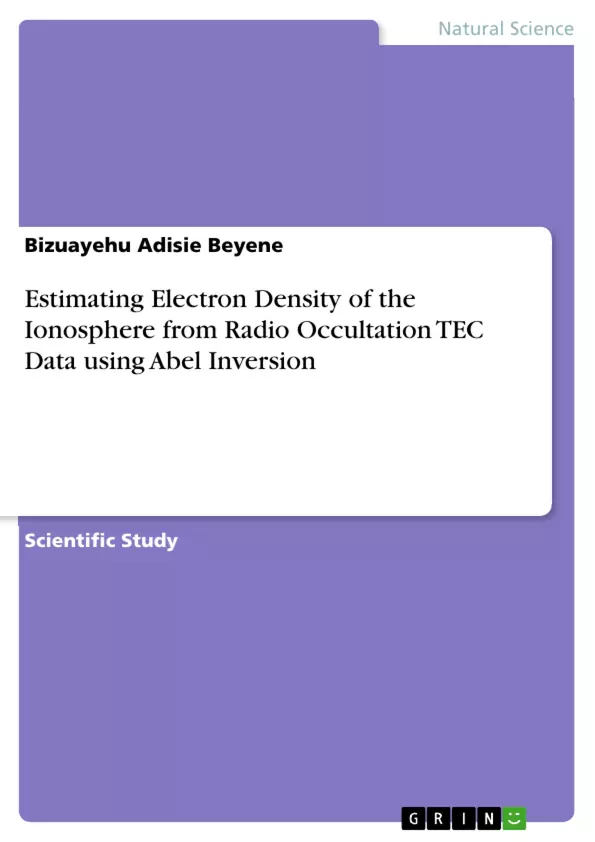Abstract Ionospheric electron density affects trans-ionospheric radio waves. Estimating electron density, therefore, is vital to mitigate the effect of ionosphere on radio waves. As a result, different methods have been applied to estimate ionospheric electron density from integrated measurements of ground-based GPS (Global Positioning System) receivers recently installed in East-Africa.
To augment such efforts, ionospheric electron density has been estimated from Radio Occultation (RO) total electron content data measured by LEO (Low Earth Orbit) satellites. Abel inversion onion peeling algorithm then is used to retrieve electron density profiles from the calibrated data. The reconstructed electron density profiles have been validated by running the standard ionospheric empirical model (International Reference Ionosphere, IRI-2007) at time and locations that RO electron density profiles are obtained. The results show well agreement between the Abel inversion and IRI-2007 electron density profiles, for both bottom and topside ionosphere. Also, F2 peak density heights from Abel inversion and IRI-2007 have shown well agreement. However, significant discrepancy has been detected around the height of the F2 peak density.
Inhaltsverzeichnis (Table of Contents)
- Introduction
- Methodology
- Results and discussion
- Conclusion and recommendation
Zielsetzung und Themenschwerpunkte (Objectives and Key Themes)
This research aims to estimate electron density in the ionosphere from Radio Occultation (RO) Total Electron Content (TEC) data measured by LEO satellites using the Abel inversion method. The study focuses on retrieving electron density profiles from calibrated TEC data, comparing these profiles with those obtained using a standard ionospheric empirical model (IRI-2007), and validating the results.
- Estimating electron density in the ionosphere using Abel inversion
- Retrieving electron density profiles from RO TEC data
- Validating retrieved electron density profiles with IRI-2007
- Analyzing discrepancies between Abel inversion and IRI-2007 results
- Exploring the applications and potential of Abel inversion for ionospheric research
Zusammenfassung der Kapitel (Chapter Summaries)
- Introduction: This chapter introduces the concept of the ionosphere, its importance for radio wave propagation, and the factors influencing its variability. It outlines the effects of ionospheric variations on radio wave applications and explores different methods for mitigating these effects. The chapter then focuses on Radio Occultation (RO) as a technique for measuring TEC and highlights the use of Abel inversion in retrieving electron density profiles.
- Methodology: This chapter delves into the methodology employed in the study, emphasizing the Abel inversion technique. It explains the principle of Abel inversion and its application to RO TEC data, focusing on the assumption of spherical symmetry in electron density. The chapter also clarifies the derivation of electron density profiles using Abel inversion and discusses the role of impact parameter and radial distance in the calculation.
- Results and discussion: This chapter presents the results of the study, focusing on the retrieved electron density profiles from RO TEC data using Abel inversion. It compares these profiles with those obtained from the IRI-2007 model and analyzes the agreement and discrepancies between the two approaches. The chapter further investigates the accuracy of the Abel inversion method and discusses the implications of the findings for ionospheric research.
Schlüsselwörter (Keywords)
This research primarily focuses on the estimation of ionospheric electron density using Abel inversion. Key keywords include: Abel inversion, electron density, radio occultation, total electron content, ionosphere, IRI-2007, and TEC data.
- Quote paper
- Bizuayehu Adisie Beyene (Author), 2016, Estimating Electron Density of the Ionosphere from Radio Occultation TEC Data using Abel Inversion, Munich, GRIN Verlag, https://www.grin.com/document/323503



